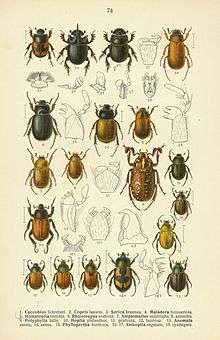Scarabaeidae
| Scarab beetle | |
|---|---|
 | |
| Central European scarab beetles with some anatomical details. Edmund Reitter's Fauna Germanica, 1908 | |
| Scientific classification | |
| Kingdom: | Animalia |
| Phylum: | Arthropoda |
| Class: | Insecta |
| Order: | Coleoptera |
| Superfamily: | Scarabaeoidea |
| Family: | Scarabaeidae Latreille, 1802 |
| Subfamilies | |
|
Aegialiinae | |
The family Scarabaeidae as currently defined consists of over 30,000 species of beetles worldwide, often called scarabs or scarab beetles. The classification of this family is fairly unstable, with numerous competing theories, and new proposals appearing quite often. Many of the subfamilies listed here probably will not be recognized very much longer, as they will likely be reduced in status below subfamily rank, or elevated to family status (the latter is most likely, e.g., with the family "Melolonthidae" already appearing in some recent classifications). Other families have been removed recently, and are nearly universally accepted (e.g., Pleocomidae, Glaresidae, Glaphyridae, Ochodaeidae, Geotrupidae, and Bolboceratidae).
Scarabs
Scarabs are stout-bodied beetles, many with bright metallic colours, measuring between 1.5 and 160 mm. They have distinctive, clubbed antennae composed of plates called lamellae that can be compressed into a ball or fanned out like leaves to sense odours. The front legs of many species are broad and adapted for digging.
The C-shaped larvae, called grubs, are pale yellow or white. Most adult beetles are nocturnal, although the flower chafers (Cetoniinae) and many leaf chafers (Rutelinae) are active during the day. The grubs mostly live underground or under debris, so are not exposed to sunlight. Many scarabs are scavengers that recycle dung, carrion, or decaying plant material. Others, such as the Japanese beetle, are devastating agricultural pests.
Some of the well-known beetles from the Scarabaeidae are Japanese beetles, dung beetles, June beetles, rose chafers (Australian, European, and North American), rhinoceros beetles, Hercules beetles and Goliath beetles.
Several members of this family have structurally coloured shells which act as left-handed circular polarisers; this was the first-discovered example of circular polarization in nature.[1]
Ancient Egypt
In Ancient Egypt, the dung beetle now known as Scarabaeus sacer (formerly Ateuchus sacer) was revered as sacred.
In his 1859 book On the Origin of Species, Charles Darwin described the genus Ateuchus as the "sacred beetle of the Egyptians."[2]
See also
- Scarab artifact
- Grapevine beetle
- Dung beetle - Scarabaeidae dung beetles play an important role in temperate and tropical environments
References
- ↑ A. A. Michelson (1911). "On metallic colourings in birds and insects". Philosophical Magazine. 21: 554–567. doi:10.1080/14786440408637061.
- ↑ Darwin, Charles (1859). On the Origin of Species. John Murray. p. 103.
Further reading
- RU Ehlers. Current and Future Use of Nematodes in Biocontrol: Practice and Commercial Aspects with Regard to Regulatory Policy Issues. Biocontrol Science and Technology Volume 6, Issue 3, 1996.
External links
| Wikispecies has information related to: Scarabaeidae |
| Wikimedia Commons has media related to Scarabaeidae. |
- Flickr Images on Flickr
- Scarabaeidae breeding site Photos of various Cetonidae, Dynastidae, Euchiridae, Lucanidae and Trichinae]
- Family SCARABAEIDAE
- June Beetles, Family: Scarabaeidae - Diagnostic photographs
- Scarab Beetle Research, Databases, and Links from Scarab Central at University of Nebraska State Museum
- Bibliography of literature published on scarab beetles since 1 January 2001 (worldwide coverage; through 2005)
- UNL Generic Guide to New World Scarabaeidae
- Heredity Scientific paper on scarab horns
